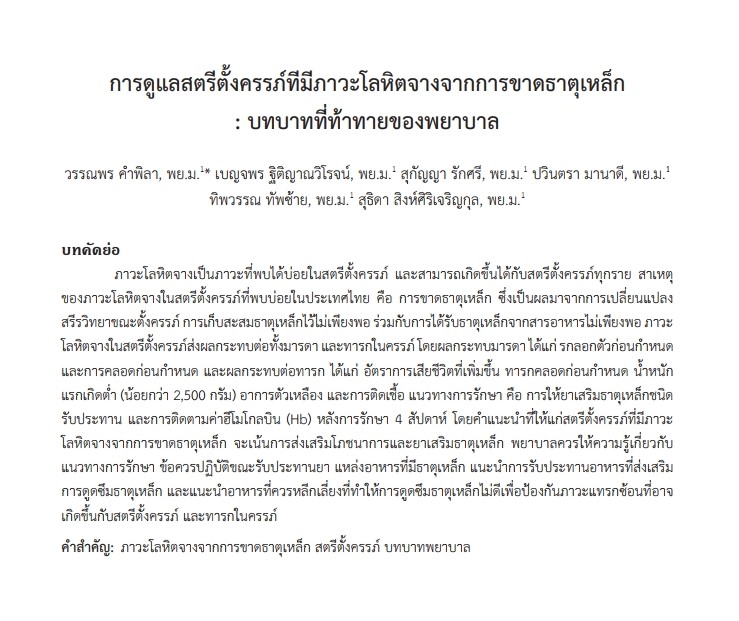การดูแลสตรีตั้งครรภ์ทีมีภาวะโลหิตจางจากการขาดธาตุเหล็ก : บทบาทที่ท้าทายของพยาบาล
คำสำคัญ:
ภาวะโลหิตจางจากการขาดธาตุเหล็ก, สตรีตั้งครรภ์ , บทบาทพยาบาลบทคัดย่อ
ภาวะโลหิตจางเป็นภาวะที่พบได้บ่อยในสตรีตั้งครรภ์ และสามารถเกิดขึ้นได้กับสตรีตั้งครรภ์ทุกราย สาเหตุของภาวะโลหิตจางในสตรีตั้งครรภ์ที่พบบ่อยในประเทศไทย คือ การขาดธาตุเหล็ก ซึ่งเป็นผลมาจากการเปลี่ยนแปลงสรีรวิทยาขณะตั้งครรภ์ การเก็บสะสมธาตุเหล็กไว้ไม่เพียงพอ ร่วมกับการได้รับธาตุเหล็กจากสารอาหารไม่เพียงพอ ภาวะโลหิตจางในสตรีตั้งครรภ์ส่งผลกระทบต่อทั้งมารดา และทารกในครรภ์ โดยผลกระทบมารดา ได้แก่ รกลอกตัวก่อนกำหนด และการคลอดก่อนกำหนด และผลกระทบต่อทารก ได้แก่ อัตราการเสียชีวิตที่เพิ่มขึ้น ทารกคลอดก่อนกำหนด น้ำหนักแรกเกิดต่ำ (น้อยกว่า 2,500 กรัม) อาการตัวเหลือง และการติดเชื้อ แนวทางการรักษา คือ การให้ยาเสริมธาตุเหล็กชนิดรับประทาน และการติดตามค่าฮีโมโกลบิน (Hb) หลังการรักษา 4 สัปดาห์ โดยคำแนะนำที่ให้แก่สตรีตั้งครรภ์ที่มีภาวะโลหิตจางจากการขาดธาตุเหล็ก จะเน้นการส่งเสริมโภชนาการและยาเสริมธาตุเหล็ก พยาบาลควรให้ความรู้เกี่ยวกับแนวทางการรักษา ข้อควรปฏิบัติขณะรับประทานยา แหล่งอาหารที่มีธาตุเหล็ก แนะนำการรับประทานอาหารที่ส่งเสริมการดูดซึมธาตุเหล็ก และแนะนำอาหารที่ควรหลีกเลี่ยงที่ทำให้การดูดซึมธาตุเหล็กไม่ดีเพื่อป้องกัน
เอกสารอ้างอิง
Abujilban, S., Hatamleh, R., & Al-Shuqerat, S. (2019). The impact of a planned health educational program on the compliance and knowledge of Jordanian pregnant women with anemia. Women & health, 59(7), 748-759.
American College of Obstetricians and Gynecologists [ACOG]. (2021). Anemia in pregnancy: ACOG practice bulletin, number 233. Obstetrics and Gynecology, 138(2), e55-e64.
Blackburn, S. (2017). Maternal, fetal, & neonatal physiology-e-book: A clinical perspective. St. Louis: Elsevier Health Sciences.
Brannon, P. M., & Taylor, C. L. (2017). Iron supplementation during pregnancy and infancy: Uncertainties and implications for research and policy. Nutrients, 9(12), 1327.
Chantanamongkol, K. (2016). Nursing care for women with congenital diseases. Pathum Thani: Rangsit University. (In Thai)
Charoenwit, T., Uerpairojkit, B., & Manotaya, S. (2008). Obstetrics (4th ed.). Bangkok: Chulalongkorn University. (In Thai)
Cunningham, F. G., Leveno, K. J., Gilstrap, L. C., & Westrom, K. D. (2018). Williams’s obstetrics (25th ed.). New York: McGraw-Hill.
Department Of Health. (2018). A guide to Thai girls with red cheeks. Retrieved from https://dol.thaihealth.or.th/Media/Pdfview/1490d5b1-3322-ea11-80e8-00155d09b41f
Finkelstein, J. L., Kurpad, A. V., Bose, B., Thomas, T., Srinivasan, K., & Duggan, C. (2020). Anaemia and iron deficiency in pregnancy and adverse perinatal outcomes in Southern India. European Journal of Clinical Nutrition, 74(1), 112-125.
Juul, S. E., Derman, R. J., & Auerbach, M. (2019). Perinatal iron deficiency: Implications for mothers and infants. Neonatology, 115(3), 269-274.
Milman, N. (2012). Oral iron prophylaxis in pregnancy: Not too little and not too much!. Journal of Pregnancy, 2012, 1-8.
Namazi, A., & Alizadeh, S. (2016). Health knowledge of pregnant women on anemia and its complication in pregnancy. Journal of Holistic Nursing and Midwifery, 26(2), 98-106.
Pavord, S., Daru, J., Prasannan, N., Robinson, S., Stanworth, S., Girling, J., & BSH Committee. (2020). UK guidelines on the management of iron deficiency in pregnancy. British Journal of Haematology, 188(6), 819-830.
Seaharattanapatum, B., Sinsuksai, N., Phumonsakul, S., & Chansatitporn, N. (2021). Effectiveness of balanced diet-iron supplement program among pregnant women with anemia: A quasi-experimental study. Pacific Rim International Journal of Nursing Research, 25(4), 653-665.
Thanyavinichkul, S., & Phonwattana, T. (2018). Development of preventive and corrective care model for anemic pregnant women at public hospital in Chiang Mai.Lanna Journal of Health Promotion & Environmental Health, 8(1), 9–23. (In Thai)
Tongsong, T., & Wanapirak, C. (2021). Obstetrics (6th ed.). Chiang Mai: Department of Obstetrics and Gynaecology, Faculty of Medicine, Chiang Mai University.
World Health Organization [WHO]. (2021). Worldwide prevalence of anemia 2016 - 2019, WHO Global database on anemia. Retrieved from https://www.who.int/data/gho/data/themes/topics/anaemia_in_women_and_children
Young, M. F., Oaks, B., Tandon, S., Martorell, R., Dewey, K., & Wendt, A. (2019). Maternal hemoglobin concentrations across pregnancy and maternal and child health: A systematic review and meta-analysis (P11-033-19). Annals of the New York Academy of Sciences, 1450(1), 47-68.
Zhang, Q., Lu, X. M., Zhang, M., Yang, C. Y., Lv, S. Y., Li, S. F., Zhong, C. Y., & Geng, S. S. (2021). Adverse effects of iron deficiency anemia on pregnancy outcome and offspring development and intervention of three iron supplements. Scientific Reports, 11(1), 1-11.

ดาวน์โหลด
เผยแพร่แล้ว
รูปแบบการอ้างอิง
ฉบับ
ประเภทบทความ
สัญญาอนุญาต

อนุญาตภายใต้เงื่อนไข Creative Commons Attribution-NonCommercial-NoDerivatives 4.0 International License.




